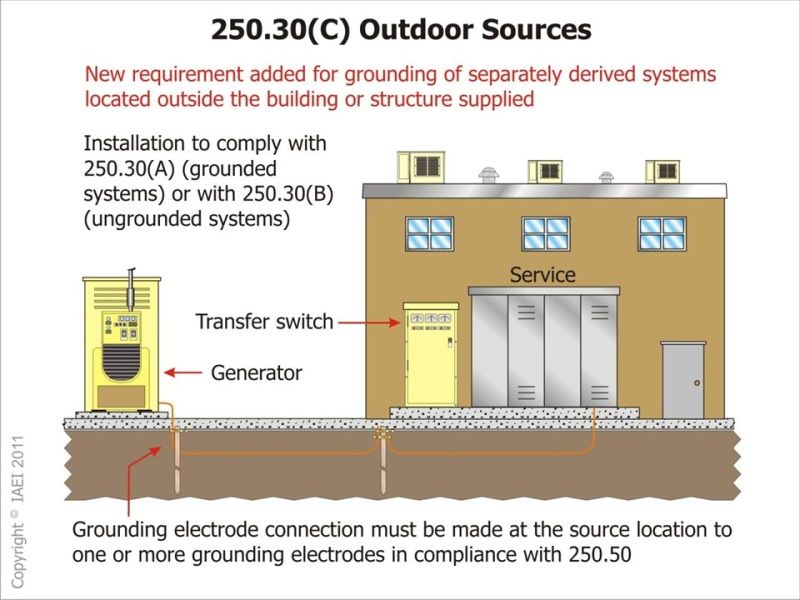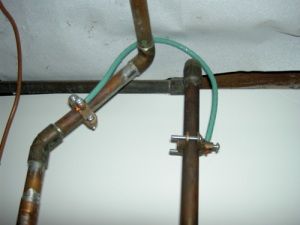jwelectric
Senior Member
- Location
- North Carolina
Does the grounding electrode system for the SDS pictured below require that the system be bonded to the building electrode system as outlined in the picture?



IMO, no... but I see how it can be interpreted that way. The deciding factor is whether the building's water or structural electrode is available [see 250.30(A)(4) and Exception No. 1 thereto]. The NEC does not provide criteria for an available determination. It could mean 10' away, or 3 miles over a mountain top (just a bit exaggerated on that last one).
I should add that the picture don't show a connection to water or structural electrodes... but that is where the SDS GES requirement starts. Aside from that, there is nothing specifically says the "remote" SDS must share the same GES as the building.
But it does not say it has to be the same GES. The way it is worded, it can be a completely separate GES, considering the SDS a separate structure.250.30 Grounding Separately Derived Alternating-Current Systems. In addition to complying with 250.30(A) for grounded systems, or as provided in 250.30(B) for ungrounded systems, separately derived systems shall comply with 250.20, 250.21, 250.22, and 250.26.
If the source is located outside the building or structure supplied, a system bonding jumper shall be installed at the grounding electrode connection in compliance with 250.30(C).
(C) Outdoor Source. If the source of the separately derived system is located outside the building or structure supplied, a grounding electrode connection shall be made at the source location to one or more grounding electrodes in compliance with 250.50. In addition, the installation shall comply with 250.30(A) for grounded systems or with 250.30(B) for ungrounded systems.
250.50 Grounding Electrode System. All grounding electrodes as described in 250.52(A)(1) through (A)(7) that are present at each building or structure served shall be bonded together to form the grounding electrode system. Where none of these grounding electrodes exist, one or more of the grounding electrodes specified in 250.52(A)(4) through (A)(8) shall be installed and used.
The answer would be yes it does need to be part of the Grounding Electrode System for the building supplied.
(4) Grounding Electrode. The grounding electrode shall
be as near as practicable to, and preferably in the same area
as, the grounding electrode conductor connection to the
system. The grounding electrode shall be the nearest of one
of the following:
(1) Metal water pipe grounding electrode as specified in
250.52(A)(1)
(2) Structural metal grounding electrode as specified in
250.52(A)(2)
Exception No. 1: Any of the other electrodes identified in
250.52(A) shall be used if the electrodes specified by
250.30(A)(4) are not available.
Exception No. 2 to (1) and (2): If a separately derived
system originates in listed equipment suitable for use as
service equipment, the grounding electrode used for the
service or feeder equipment shall be permitted as the
grounding electrode for the separately derived system.
Informational Note No. 1: See 250.104(D) for bonding
requirements for interior metal water piping in the area
served by separately derived systems.
Informational Note No. 2: See 250.50 and 250.58 for requirements
for bonding all electrodes together if located at
the same building or structure.
What if the SDS is a high voltage source and the service is of low voltage and the ground of each is of low resistance? In such a case it may be desirable to bond them together.How would that be any different than a meter and disco on a pole in a yard feeding the structure. I have never seen anyone run the gec back to the disconnects on the building.
So which is it, do we bond the electrodes together as the picture or are they not required to be bonded together as outlined in the verbiage of the code sections mention thus far?
Aye.So if I am reading this thread correctly then it is the opinion of those posters that what is pictured is not a requirement but just a picture, correct?

Well if this picture was made by the IAEI and is not enforceable how about any other picture that might be published?
I agree that pictures and verbiage found in the NEC are two different things and that only the verbiage can be enforced but we still find some that find pictures and try to enforce what they see in the picture. A very good example of this is what has been hashed out and rehashed out in this forum concerning this picture published by the IAEI in their magazine.

Either is nothing more than a picture and totally unenforceable. We must use the verbiage found in the NEC instead of looking at a bunch of pictures and saying this is how things are to be done.
I agree with you. Have to... it's Code.I still contend that all ground electrodes that are present at the building or structure served shall be bonded together as stated in 250.50 to create the Grounding Electrode System.
The connection to the grounding electrode at the building would not make a real change in the voltage to earth under fault conditions, except for a very small area very close to the building grounding electrode. Everything else at the building will be energized with a voltage that is equal to the voltage drop of the fault return path between the power source and the main or system bonding jumper. This is true anytime there is a fault, SDS or not. Everything connected to the electrical grounding system will have this elevated voltage until the fault is cleared, but the earth and metallic objects with a path to earth will remain at "earth" potential....
Suppose there is a ground fault in the building while the SDS is on. Most of the fault current would return to the SDS via EGC/ neutral of the SDS. But some of the fault current would return via service connection GEC, ground and GEC of the SDS. So there would be neutral to ground voltage at service equipment enclosure as well as at the SDS metallic enclosure for the duration of time, the protective device operates to clear the ground fault. This voltage can be hazardous. But this voltage can be made negligible by bonding the ground rods of the two sources as shown in the OP.

